Wideband Singly Fed Compact Circularly Polarized Rectangular Dielectric Resonator Antenna for X-Band Wireless Applications
Abstract
:1. Introduction
2. Antenna Geometry and Design
3. Antenna Design and Analysis
4. Parametric Study
5. Final Simulated and Measured Results
6. Conclusions
Author Contributions
Funding
Data Availability Statement
Acknowledgments
Conflicts of Interest
References
- Counselman, C.C. Multipath-rejecting GPS antennas. Proc. IEEE 1999, 87, 86–91. [Google Scholar] [CrossRef]
- Banerjee, U.; Karmakar, A.; Saha, A. A review on circularly polarized antennas, trends and advances. Int. J. Microw. Wirel. Technol. 2020, 12, 922–943. [Google Scholar] [CrossRef]
- Kumar, R.; Chaudhary, R.K. Stacked rectangular dielectric resonator antenna with different volumes for wideband circular polarization coupled with step-shaped conformal strip. Int. J. RF Microw. Comput.-Aided Eng. 2019, 29, e21667. [Google Scholar] [CrossRef]
- Kumar, R.; Chaudhary, R.K. A wideband circularly polarized cubic dielectric resonator antenna excited with modified microstrip feed. IEEE Antennas Wirel. Propag. Lett. 2015, 15, 1285–1288. [Google Scholar] [CrossRef]
- Petosa, A. Dielectric Resonator Antenna Handbook; Artech: Morristown, NJ, USA, 2007. [Google Scholar]
- Mongia, R.K.; Bhartia, P. Dielectric resonator antennas—A review and general design relations for resonant frequency and bandwidth. Int. J. Microw. Millim. -Wave Comput. -Aided Eng. 1994, 4, 230–247. [Google Scholar] [CrossRef]
- Khattak, M.A.; Khattak, M.I.; Owais, S.M.; Khattak, A.A.; Sultan, A. Design and analysis of millimeter wave dielectric resonator antenna for 5G wireless communication systems. Prog. Electromagn. Res. C 2020, 98, 239–255. [Google Scholar]
- Petosa, A.; Ittipiboon, A. Dielectric resonator antennas: A historical review and the current state of the art. IEEE Antennas Propag. Mag. 2010, 52, 91–116. [Google Scholar] [CrossRef]
- Leung, K.W.; Lim, E.H.; Fang, X.S. Dielectric resonator antennas: From the basic to the aesthetic. Proc. IEEE 2012, 100, 2181–2193. [Google Scholar] [CrossRef]
- Meher, P.R.; Behera, B.R.; Mishra, S.K. Design and its state-of-the-art of different shaped dielectric resonator antennas at millimeter-wave frequency band. Int. J. RF Microw. Comput. -Aided Eng. 2020, 30, e22221. [Google Scholar] [CrossRef]
- Dash, S.K.K.; Khan, T.; De, A. Dielectric resonator antennas: An application oriented survey. Int. J. RF Microw. Comput. -Aided Eng. 2017, 27, e21069. [Google Scholar] [CrossRef]
- Meher, P.R.; Behera, B.R.; Mishra, S.K.; Althuwayb, A.A. A chronological review of circularly polarized dielectric resonator antenna: Design and developments. Int. J. RF Microw. Comput. -Aided Eng. 2021, 31, e22589. [Google Scholar] [CrossRef]
- Balanis, C.A. Antenna Theory, 3rd ed.; Wiley: Hoboken, NJ, USA, 2005. [Google Scholar]
- Lukand, K.M.; Leung, K.W. Dielectric Resonator Antennas; Research Studies: Baldock, UK, 2003. [Google Scholar]
- Zou, M.; Pan, J.; Nie, Z. A wideband circularly polarized rectangular dielectric resonator antenna excited by an archimedean spiral slot. IEEE Antennas Wirel. Propag. Lett. 2014, 14, 446–449. [Google Scholar] [CrossRef]
- Wang, K.X.; Wong, H. A circularly polarized antenna by using rotated-stair dielectric resonator. IEEE Antennas Wirel. Propag. Lett. 2014, 14, 787–790. [Google Scholar] [CrossRef]
- Zou, M.; Pan, J. Wideband hybrid circularly polarised rectangular dielectric resonator antenna excited by modified cross-slot. Electron. Lett. 2014, 50, 1123–1125. [Google Scholar] [CrossRef]
- Pan, Y.; Leung, K.W. Wideband circularly polarized trapezoidal dielectric resonator antenna. IEEE Antennas Wirel. Propag. Lett. 2010, 9, 588–591. [Google Scholar] [CrossRef]
- Varshney, G.; Pandey, V.S.; Yaduvanshi, R.S.; Kumar, L. Wide band circularly polarized dielectric resonator antenna with stair-shaped slot excitation. IEEE Trans. Antennas Propag. 2016, 65, 1380–1383. [Google Scholar] [CrossRef]
- Fakhte, S.; Oraizi, H.; Karimian, R.; Fakhte, R. A new wideband circularly polarized stair-shaped dielectric resonator antenna. IEEE Trans. Antennas Propag. 2015, 63, 1828–1832. [Google Scholar] [CrossRef]
- Lu, L.; Jiao, Y.C.; Zhang, H.; Wang, R.; Li, T. Wideband circularly polarized antenna with stair-shaped dielectric resonator and open-ended slot ground. IEEE Antennas Wirel. Propag. Lett. 2016, 15, 1755–1758. [Google Scholar] [CrossRef]
- Patel, P.; Mukherjee, B.; Mukherjee, J. Wideband circularly polarized rectangular dielectric resonator antennas using square-shaped slots. IEEE Antennas Wirel. Propag. Lett. 2015, 15, 1309–1312. [Google Scholar] [CrossRef]
- Varshney, G. Gain and bandwidth enhancement of a singly-fed circularly polarised dielectric resonator antenna. IET Microw. Antennas Propag. 2020, 14, 1323–1330. [Google Scholar] [CrossRef]
- Sun, Y.X.; Leung, K.W.; Mao, J.F. Dual function dielectric resonator as antenna and phase-delay-line load: Designs of compact circularly polarized/differential antennas. IEEE Trans. Antennas Propag. 2017, 66, 414–419. [Google Scholar] [CrossRef]
- Podilchak, S.K.; Johnstone, J.C.; Caillet, M.; Clénet, M.; Antar, Y.M. A compact wideband dielectric resonator antenna with a meandered slot ring and cavity backing. IEEE Antennas Wirel. Propag. Lett. 2015, 15, 909–913. [Google Scholar] [CrossRef]
- Chair, R.; Yang, S.L.S.; Kishk, A.A.; Lee, K.F.; Luk, K.M. Aperture fed wideband circularly polarized rectangular stair shaped dielectric resonator antenna. IEEE Trans. Antennas Propag. 2006, 54, 1350–1352. [Google Scholar] [CrossRef]
- Fakhte, S.; Oraizi, H.; Karimian, R. A novel low-cost circularly polarized rotated stacked dielectric resonator antenna. IEEE Antennas Wirel. Propag. Lett. 2014, 13, 722–725. [Google Scholar] [CrossRef]
- Altaf, A.; Yang, Y.; Lee, K.Y.; Hwang, K.C. Circularly polarized Spidron fractal dielectric resonator antenna. IEEE Antennas Wirel. Propag. Lett. 2015, 14, 1806–1809. [Google Scholar] [CrossRef]
- Yadav, S.K.; Kaur, A.; Khanna, R. Broadband circularly polarized dielectric resonator antenna for UWB applications. Sādhanā 2022, 47, 1–8. [Google Scholar] [CrossRef]
- Elahi, M.; Altaf, A.; Yang, Y.; Lee, K.Y.; Hwang, K.C. Circularly polarized dielectric resonator antenna with two annular vias. IEEE Access. 2021, 9, 41123–41128. [Google Scholar] [CrossRef]
- Khan, S.; Ali, H.; Khalily, M.; Shah SU, A.; Kazim JU, R.; Ali, H.; Tanougast, C. Miniaturization of Dielectric Resonator Antenna by Using Artificial Magnetic Conductor Surface. IEEE Access. 2020, 8, 68548–68558. [Google Scholar] [CrossRef]
- Chakraborty, P.; Banerjee, U.; Saha, A.; Karmakar, A. A compact ultra wideband dielectric resonator antenna with dual-band circular polarization characteristics. Int. J. RF Microw. Comput. -Aided Eng. 2021, 31, e22577. [Google Scholar] [CrossRef]
- Yang, W.W.; Sun, W.J.; Tang, H.; Chen, J.X. Design of a circularly polarized dielectric resonator antenna with wide bandwidth and low axial ratio values. IEEE Trans. Antennas Propag. 2019, 67, 1963–1968. [Google Scholar] [CrossRef]
- Kumar, R.; Thummaluru, S.R.; Chaudhary, R.K. Improvements in Wi-MAX reception: A new dual-mode wideband circularly polarized dielectric resonator antenna. IEEE Antennas Propag. Mag. 2019, 61, 41–49. [Google Scholar] [CrossRef]
- Kumar, R.; Chaudhary, R.K. A New Bidirectional Wideband Circularly Polarized Cylindrical Dielectric Resonator Antenna using Modified J-shaped Ground Plane for WiMAX/LTE Applications. Radioengineering 2019, 28, 391–398. [Google Scholar] [CrossRef]
- Varshney, G.; Pandey, V.S.; Yaduvanshi, R.S. Axial ratio bandwidth enhancement of a circularly polarized rectangular dielectric resonator antenna. Int. J. Microw. Wirel. Technol. 2018, 10, 984–990. [Google Scholar] [CrossRef]
- Kumari, R.; Gangwar, R.K. Circularly polarized slot-coupled square dielectric resonator antenna for WLAN applications. Microw. Opt. Technol. Lett. 2018, 60, 2787–2794. [Google Scholar] [CrossRef]
- Kumar, R.; Nasimuddin, N.; Chaudhary, R.K. A new dual C-shaped rectangular dielectric resonator based antenna for wideband circularly polarized radiation. Int. J. RF Microw. Comput. -Aided Eng. 2019, 29, e21672. [Google Scholar] [CrossRef]
- Varshney, G.; Gotra, S.; Pandey, V.S.; Yaduvanshi, R.S. Inverted-sigmoid shaped multiband dielectric resonator antenna with dual-band circular polarization. IEEE Trans. Antennas Propag. 2018, 66, 2067–2072. [Google Scholar] [CrossRef]
- Dash, S.K.K.; Khan, T.; Kanaujia, B.K. Circularly polarized dual facet spiral fed compact triangular dielectric resonator antenna for sensing applications. IEEE Sens. Lett. 2018, 2, 1–4. [Google Scholar] [CrossRef]
- Chowdhury, R.; Chaudhary, R.K. An approach to generate circular polarization in a modified cylindrical-shaped dielectric resonator antenna using PMC boundary approximation. IEEE Antennas Wirel. Propag. Lett. 2018, 17, 1727–1731. [Google Scholar] [CrossRef]
- Chowdhury, R.; Mishra, N.; Sani MMand Chaudhary, R.K. Analysis of a wideband circularly polarized cylindrical dielectric resonator antenna with broadside radiation coupled with simple microstrip feeding. IEEE Access 2017, 5, 19478–19485. [Google Scholar] [CrossRef]
- Gupta, A.; Gangwar, R.K. Dual-band circularly polarized aperture coupled rectangular dielectric resonator antenna for wireless applications. IEEE Access 2018, 6, 11388–11396. [Google Scholar] [CrossRef]
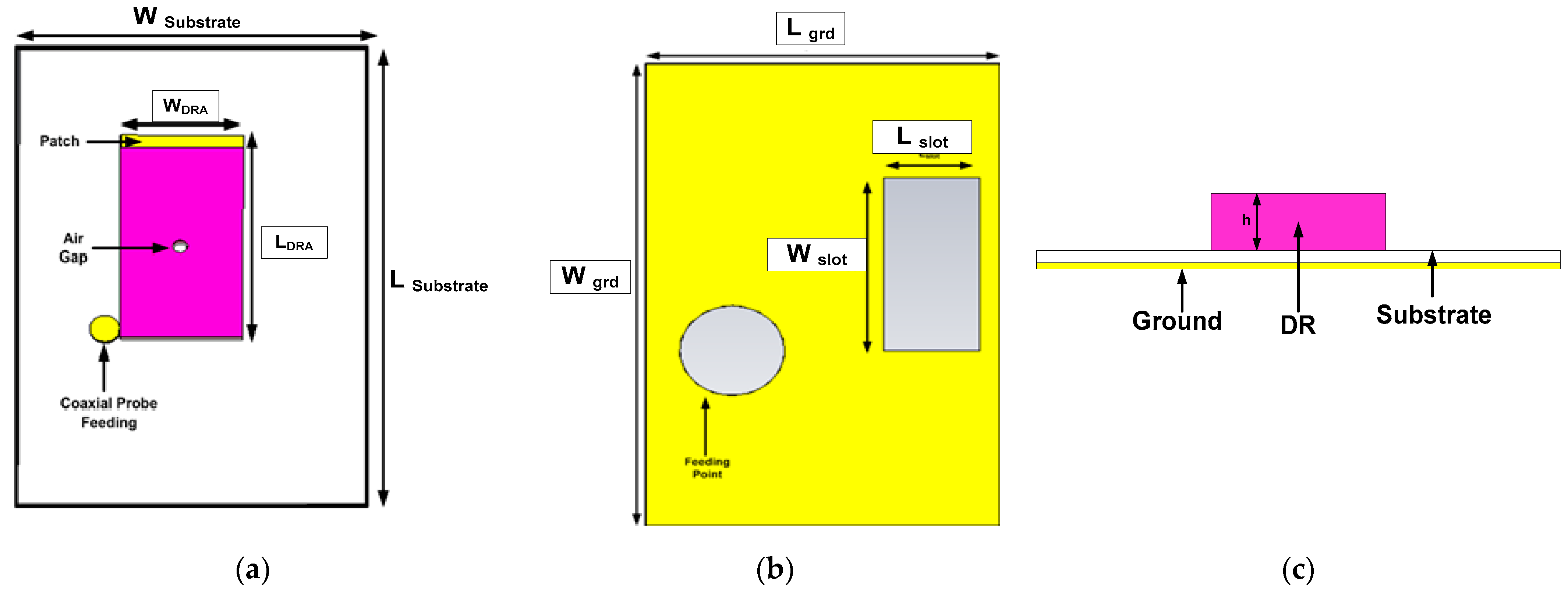

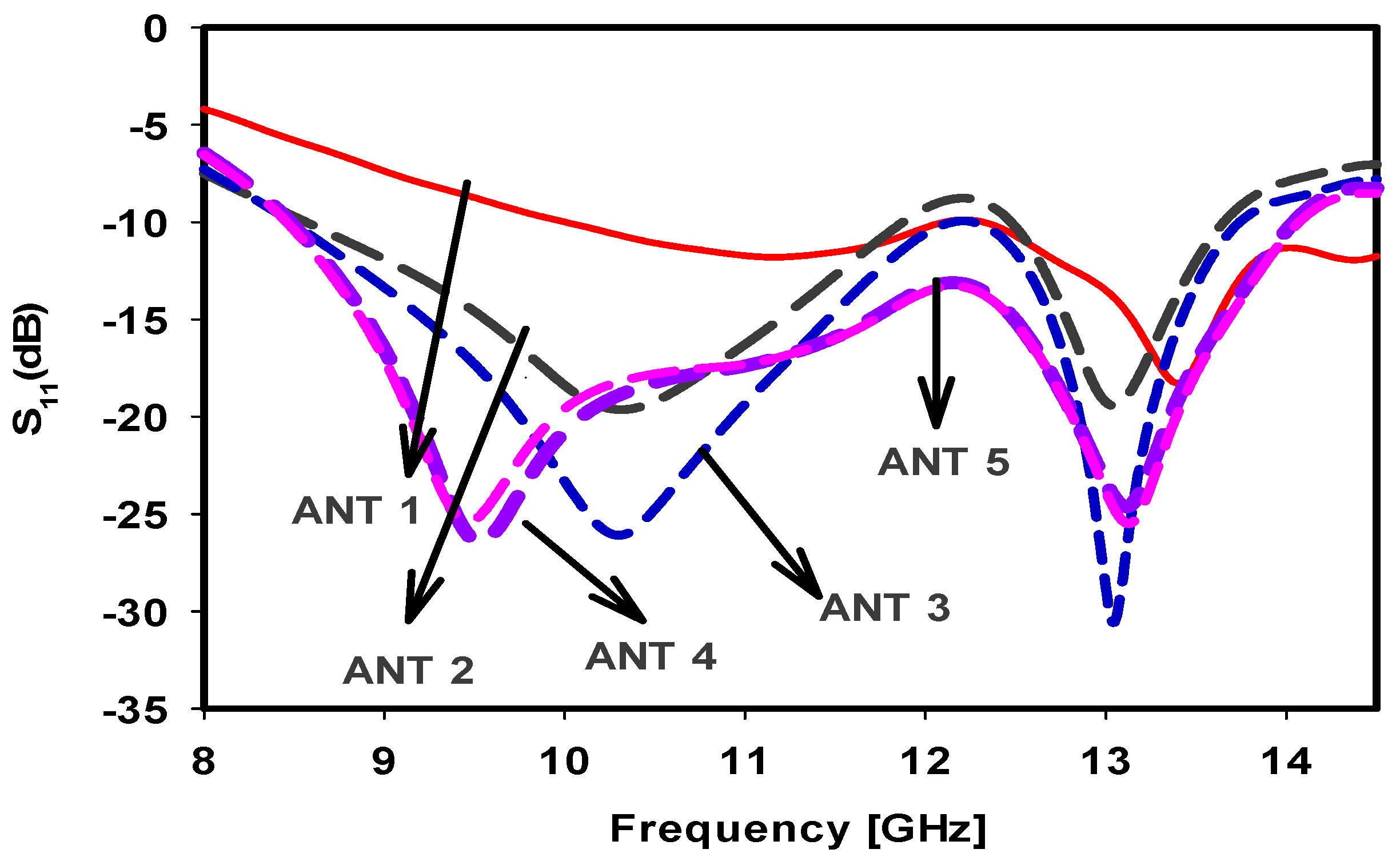

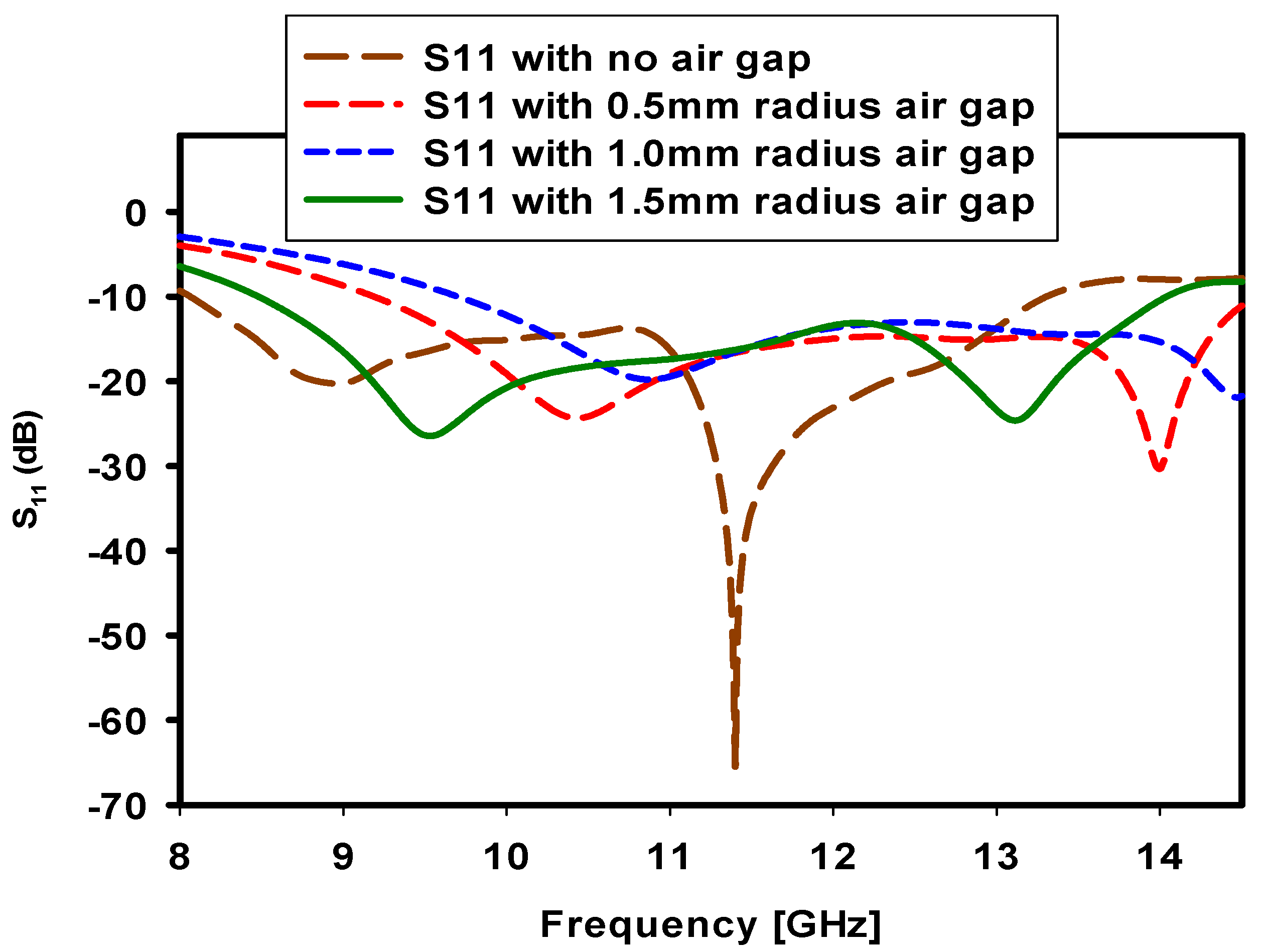
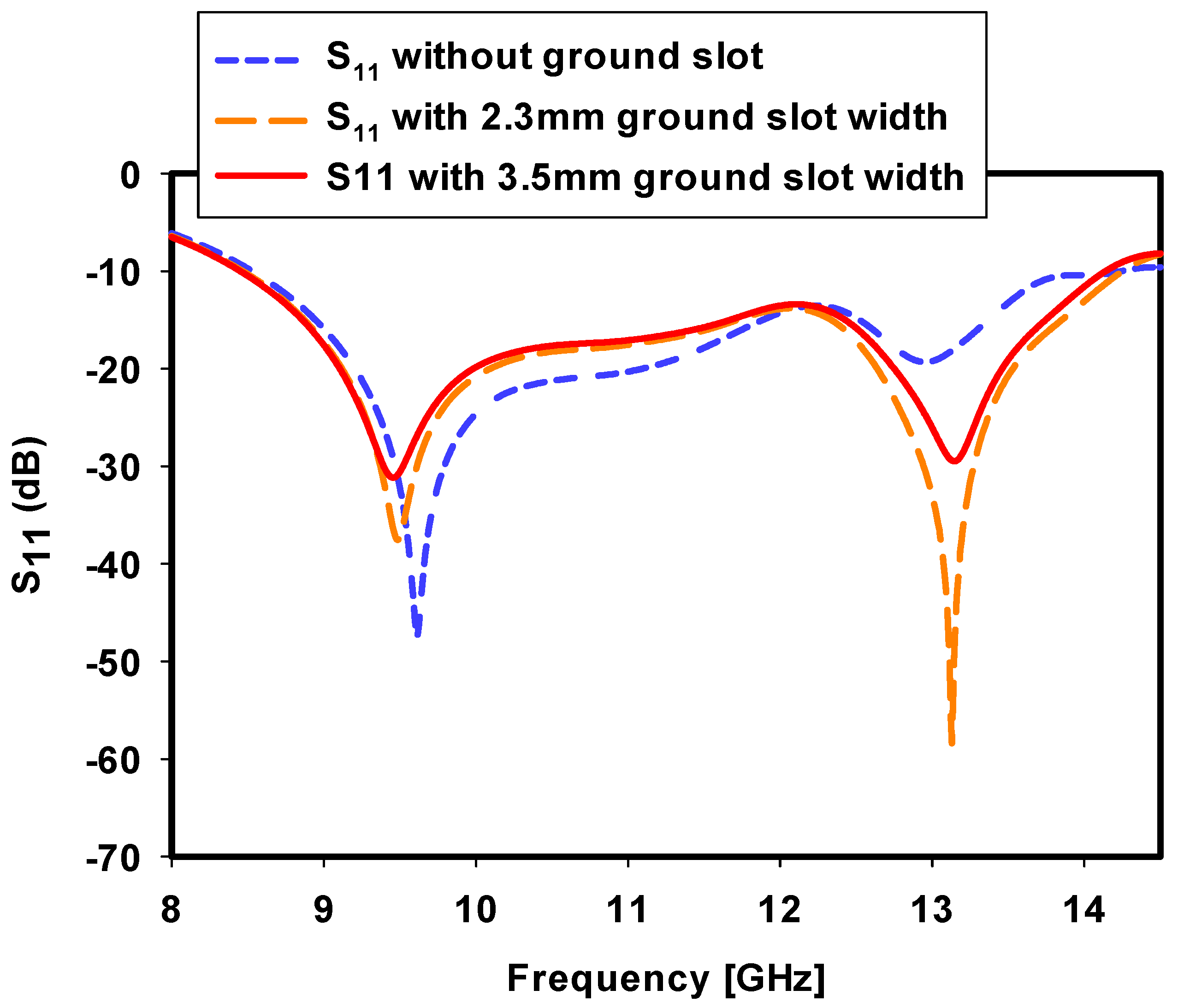
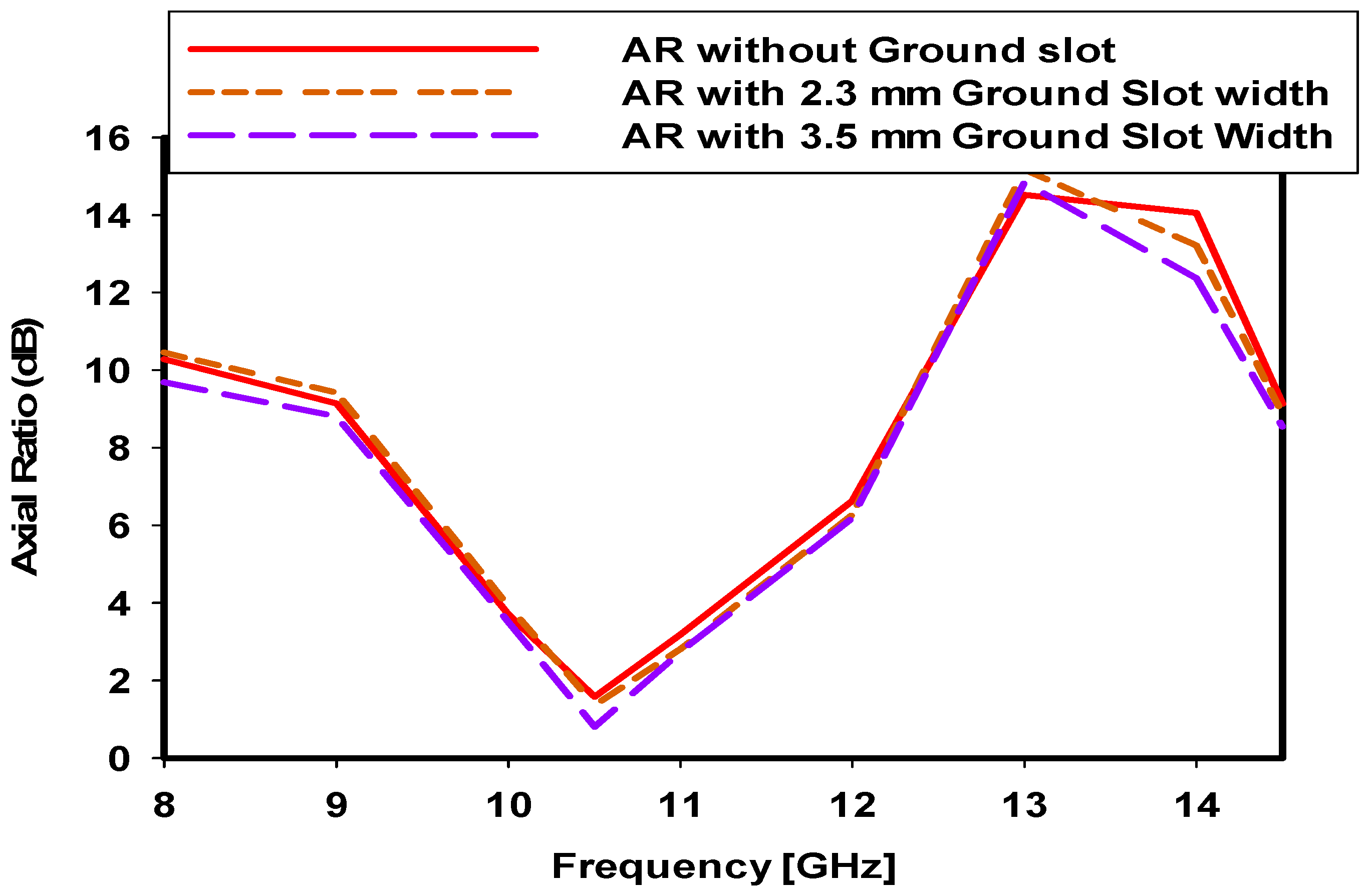
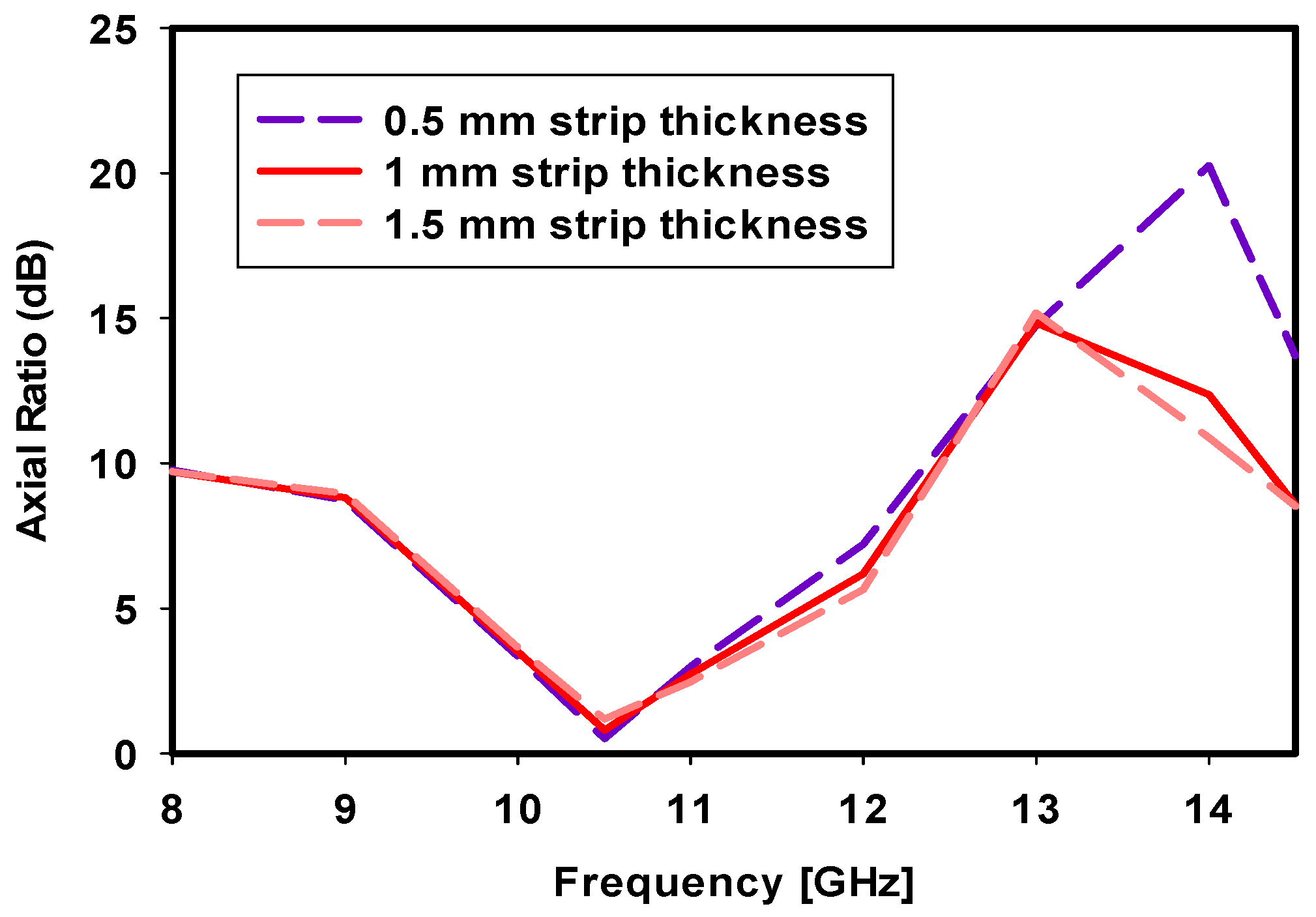
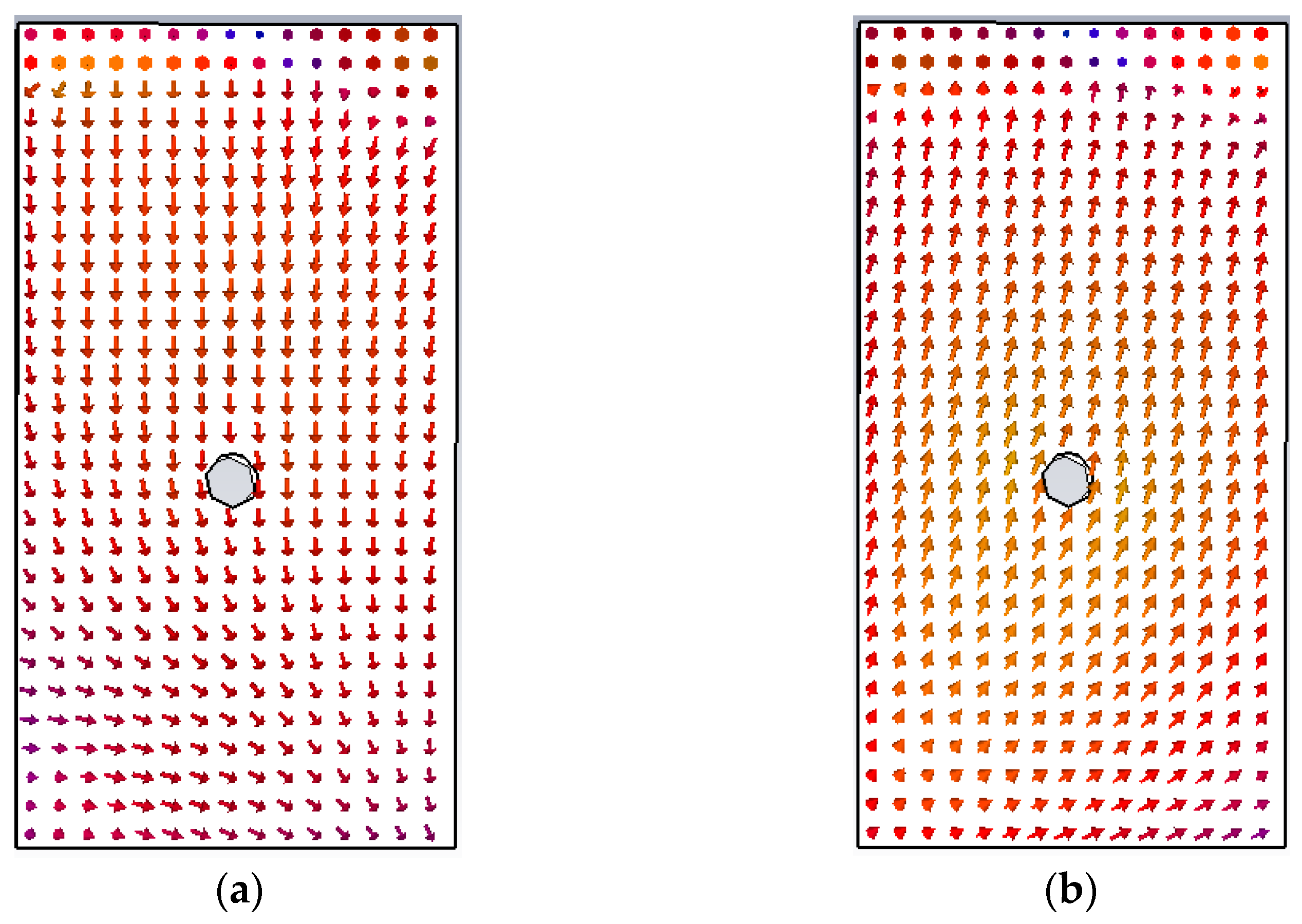

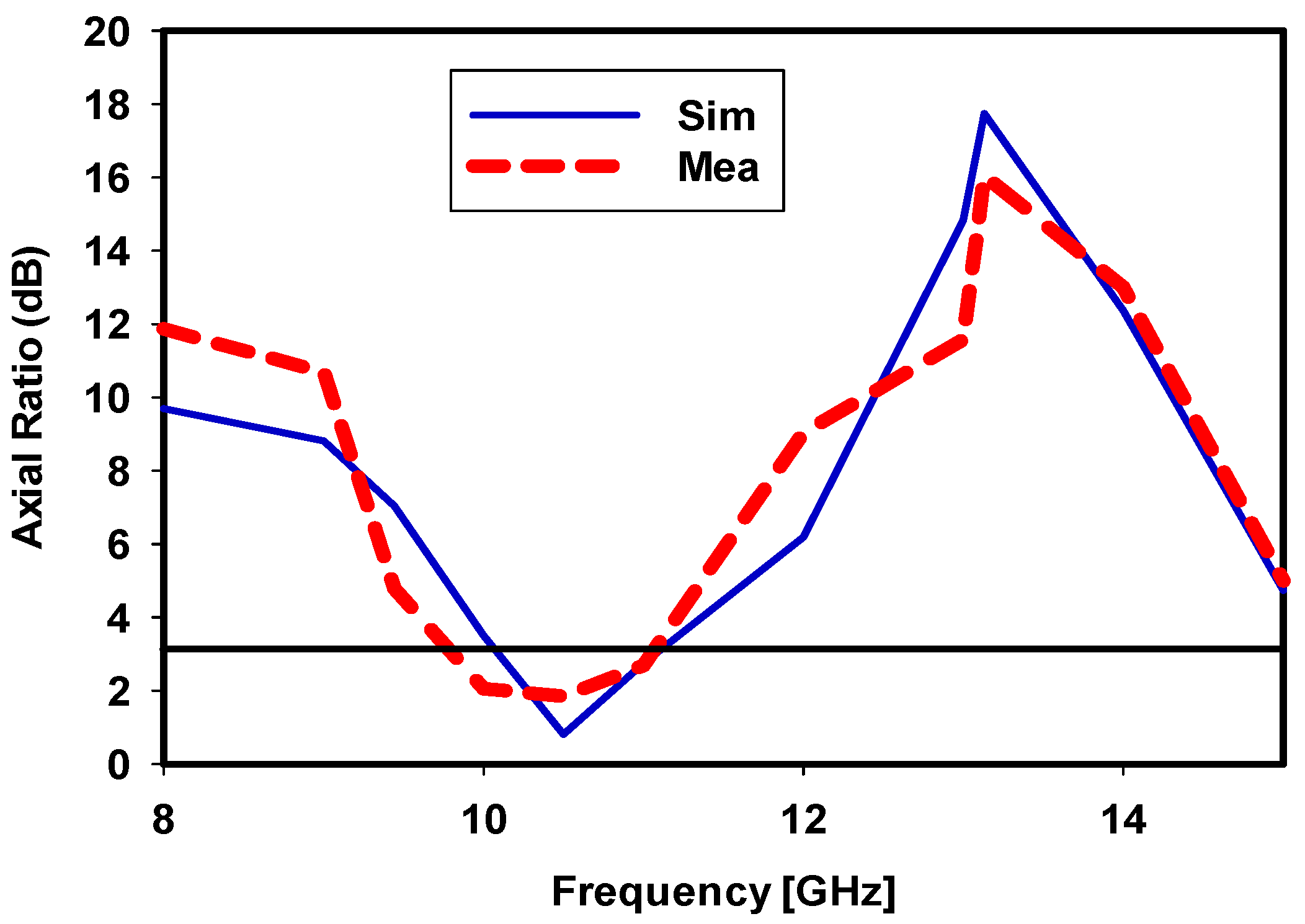
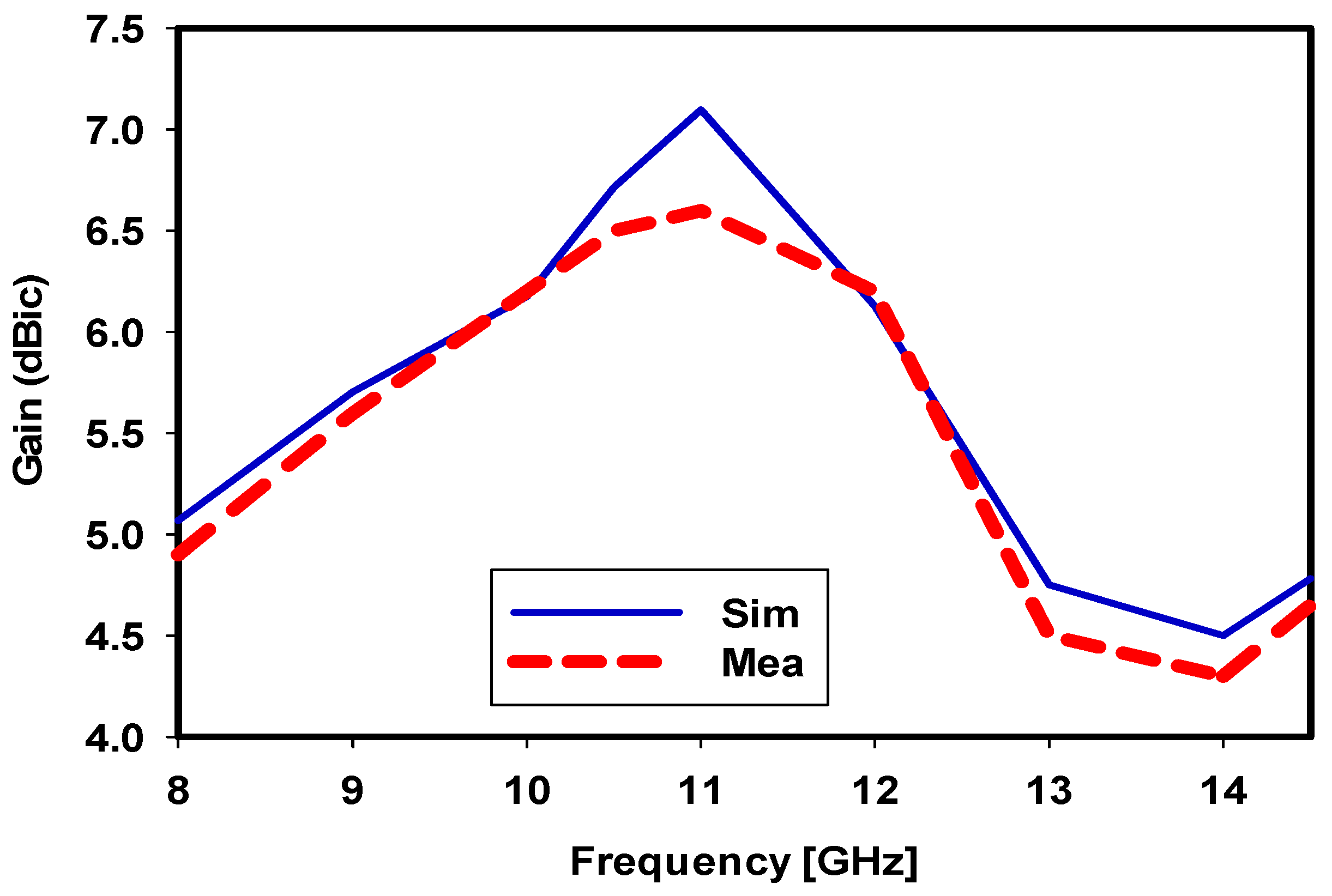
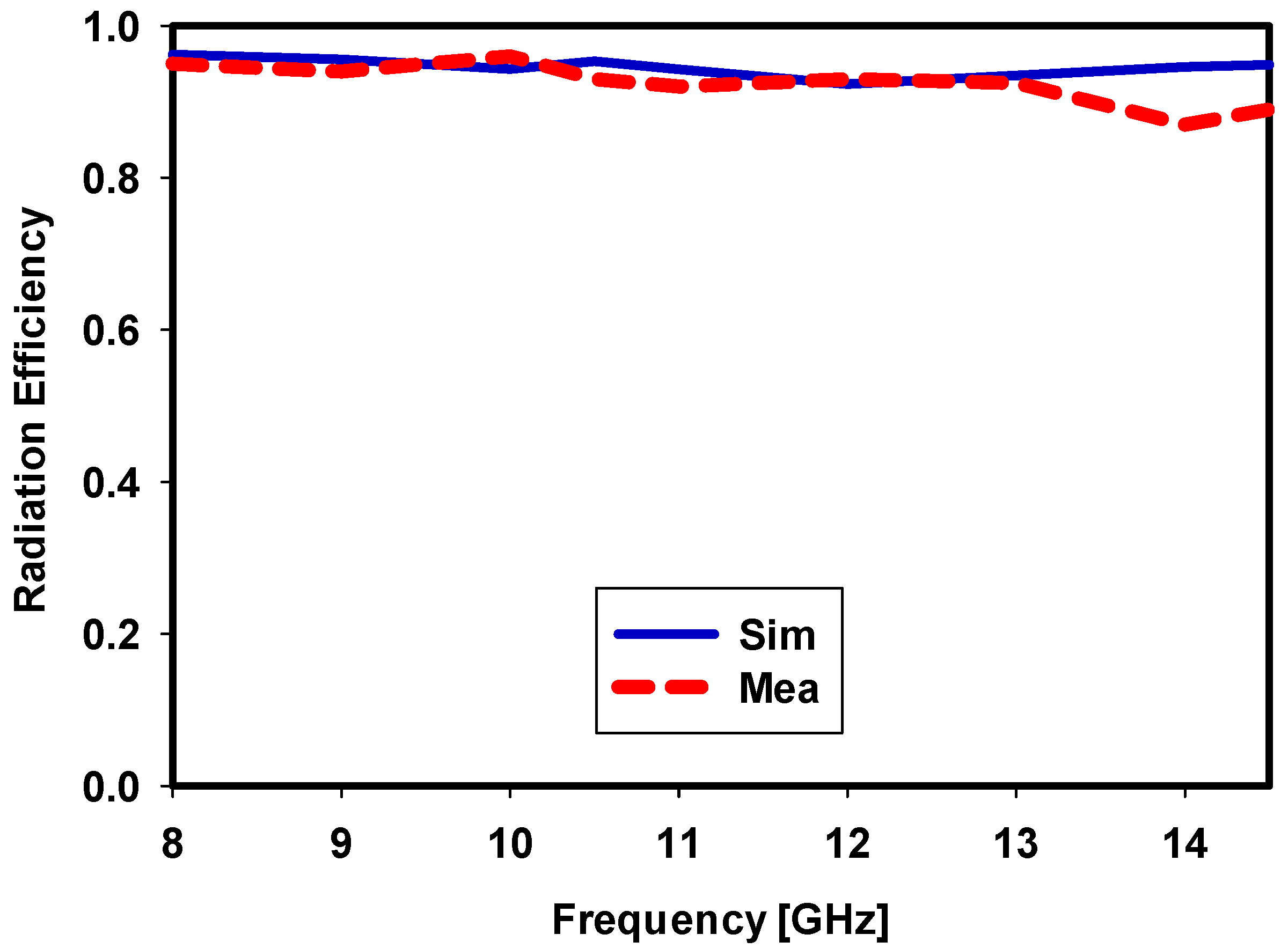

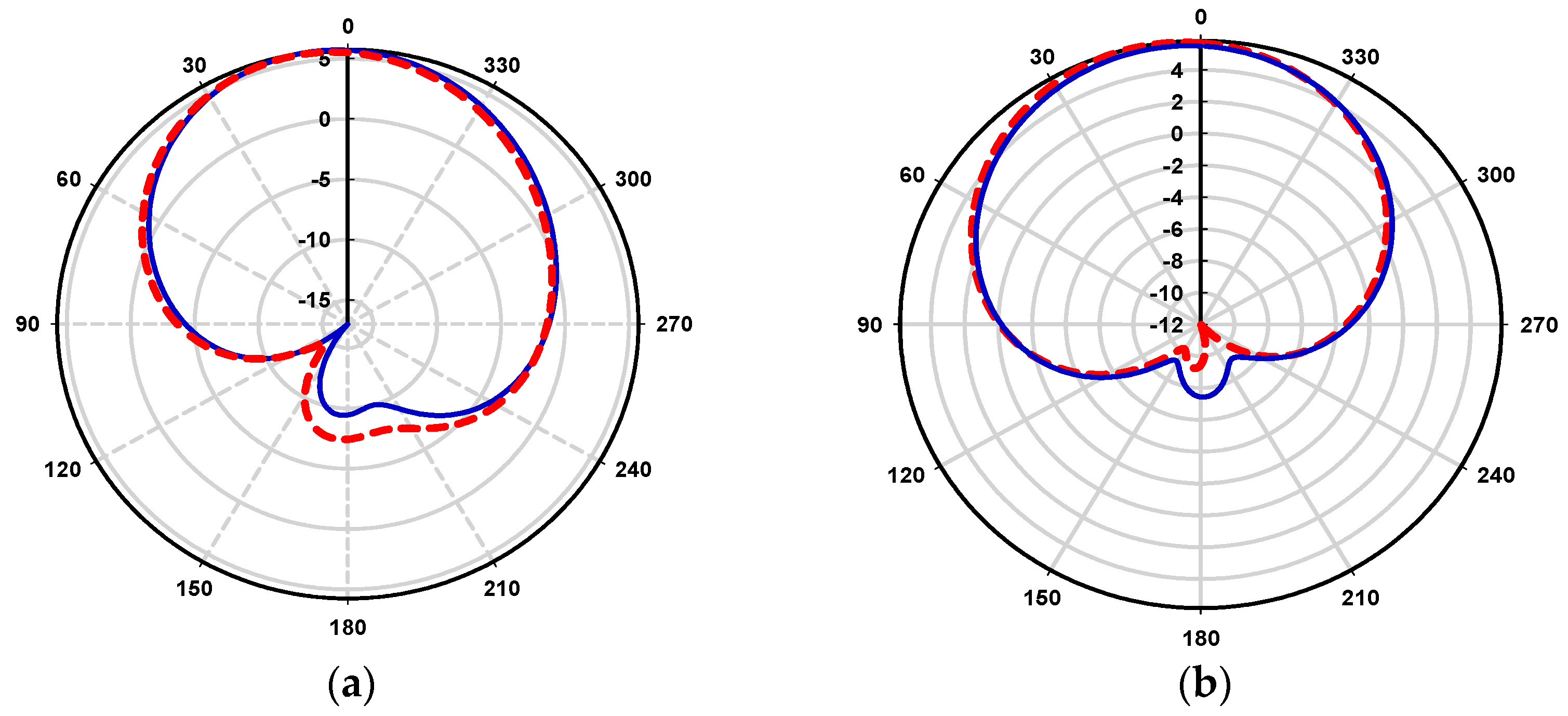


| Parameters | Size (mm) | Parameters | Size (mm) |
|---|---|---|---|
| Wsub | 14 | Wgrd | 14 |
| Lsub | 21 | Lgrd | 21 |
| WDRA | 9.2 | Wslot | 7.5 |
| LDRA | 4.9 | Lslot | 3.7 |
| Top Patch Length | 1.5 | hDRA | 5.12 |
| Size (mm3)/λ3 | BW (GHz) | AR BW (GHz) | AR BW (%) | Gain | Max. Eff. (%) | Ref. |
|---|---|---|---|---|---|---|
| 90 × 90 × 15/1.88 × 1.88 × 0.31 | 0.25 | 0.25 | 5.5 | 6–7 dBic | 96 | [30] |
| 63 × 75 × 6.1/1.05 × 1.25 × 0.10 | 10.9 | 0.7 | 17.28, 11.56 | 7 dBi | 83 | [32] |
| 23 × 23 × 2/1.64 × 1.64 × 0.14 | 3 | 2.5 | 27 | 6.5 dB | -- | [33] |
| 40 × 40 × 18/0.94 × 0.94 × 0.42 | 1 | 0.4 | 17.5 | 4.2 dBic | 87 | [34] |
| 40 × 32 × 14/1.04 × 0.83 × 0.36 | 1.5 | 1.1 | 29.9 | 2.8 dBic | 94 | [35] |
| 80 × 80 × 5/2.65 × 2.65 × 0.16 | 4.1 | 3.3 | 56.6 | 2.7 dBic | 80 | [36] |
| 44 × 45 × 11/2.65 × 2.65 × 0.16 | 0.5 | 0.1 | 7.94 | 4 dB | 95 | [37] |
| 45 × 40 × 15/1.15 × 1.02 × 0.38 | 0.9 | 0.4 | 12.3 | 5.2 dBic | 88 | [38] |
| 50 × 50 × 5/2.08 × 2.08 × 0.20 | 3, 1.1 | 1.3, 0.3 | 19.34, 3.15 | 4.38 dBi, 6.4 dBi | 80 | [39] |
| 50 × 50 × 10/3.95 × 3.95 × 0.79 | 0.4, 1.1 | 0.2, 0.2 | 1.6, 1.8 | 2.2 dBi, 3.7 dBi | 90 | [40] |
| 50 × 50 × 16/1.29 × 1.29 × 0.41 | 2.0 | 0.3 | 7.7 | 5 dBic | -- | [41] |
| 55 × 55 × 23/1.14 × 1.14 × 0.47 | 1.0 | 0.8 | 23.7 | 5.5 dBi | 96 | [42] |
| 40 × 40 × 8/0.97 × 0.97 × 0.19 | 1.1, 0.9 | 0.02, 0.37 | 1.03, 3.4 | 5.3 dBi, 5.7 dBi | 93, 96 | [43] |
| 14 × 21 × 5.1/0.66 × 1.00 × 0.24 | 5.64 | 1.1 | 9.5 | 6.5 dBic | 95.5 | This Work |
Publisher’s Note: MDPI stays neutral with regard to jurisdictional claims in published maps and institutional affiliations. |
© 2022 by the authors. Licensee MDPI, Basel, Switzerland. This article is an open access article distributed under the terms and conditions of the Creative Commons Attribution (CC BY) license (https://creativecommons.org/licenses/by/4.0/).
Share and Cite
Khan, S.; Khan, M.A.; Anab, M.; Marwat, S.N.K.; Jan, N.; Ghoniem, R.M. Wideband Singly Fed Compact Circularly Polarized Rectangular Dielectric Resonator Antenna for X-Band Wireless Applications. Electronics 2022, 11, 3281. https://doi.org/10.3390/electronics11203281
Khan S, Khan MA, Anab M, Marwat SNK, Jan N, Ghoniem RM. Wideband Singly Fed Compact Circularly Polarized Rectangular Dielectric Resonator Antenna for X-Band Wireless Applications. Electronics. 2022; 11(20):3281. https://doi.org/10.3390/electronics11203281
Chicago/Turabian StyleKhan, Shahid, Muhammad Amir Khan, Muhammad Anab, Safdar Nawaz Khan Marwat, Naveed Jan, and Rania M. Ghoniem. 2022. "Wideband Singly Fed Compact Circularly Polarized Rectangular Dielectric Resonator Antenna for X-Band Wireless Applications" Electronics 11, no. 20: 3281. https://doi.org/10.3390/electronics11203281
APA StyleKhan, S., Khan, M. A., Anab, M., Marwat, S. N. K., Jan, N., & Ghoniem, R. M. (2022). Wideband Singly Fed Compact Circularly Polarized Rectangular Dielectric Resonator Antenna for X-Band Wireless Applications. Electronics, 11(20), 3281. https://doi.org/10.3390/electronics11203281








